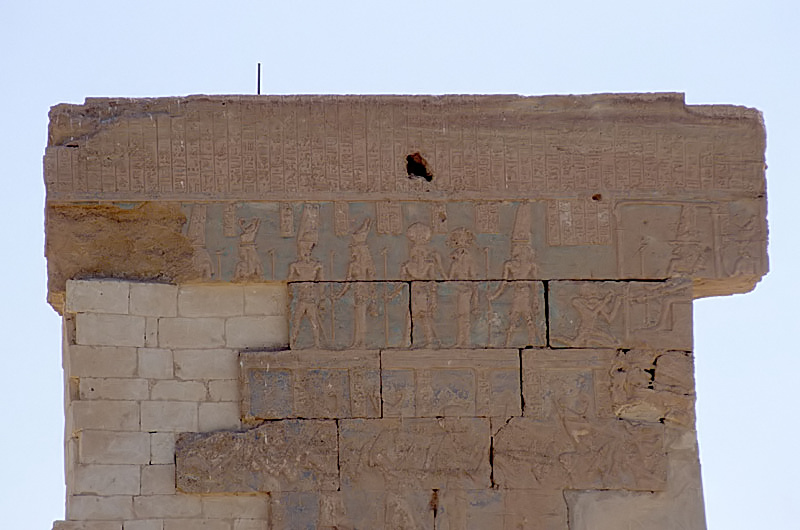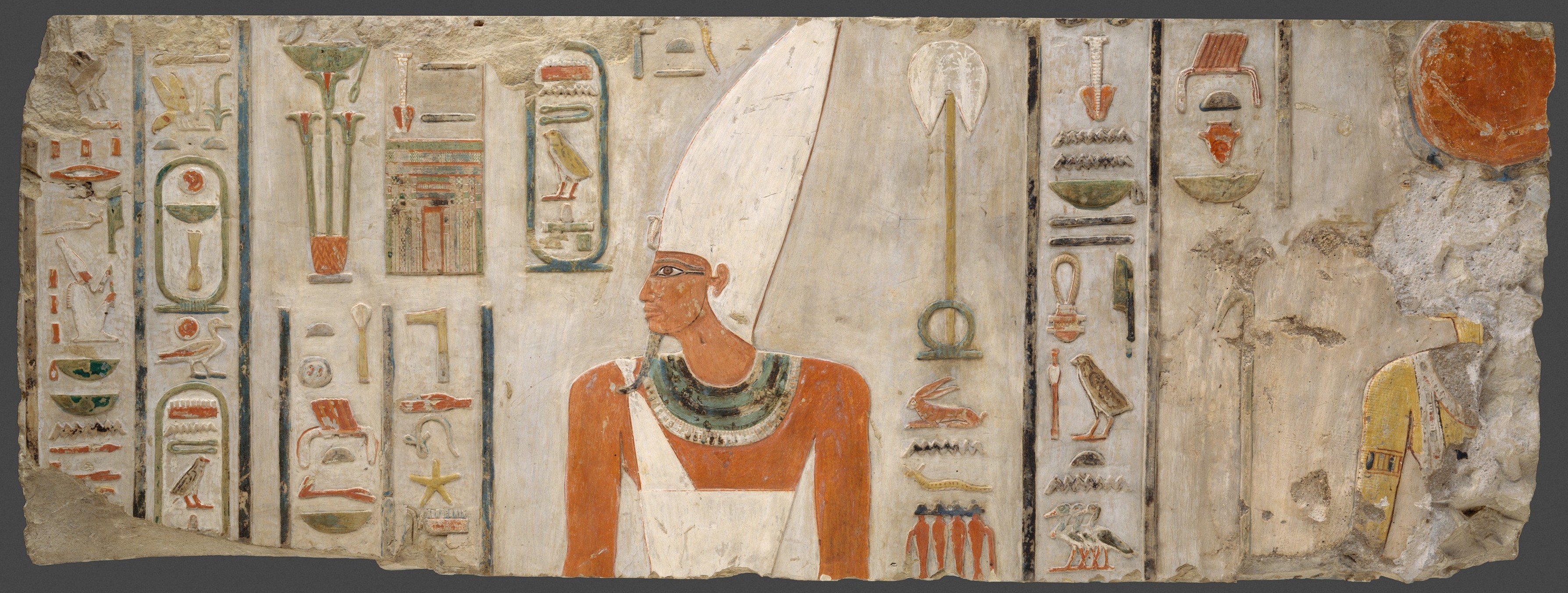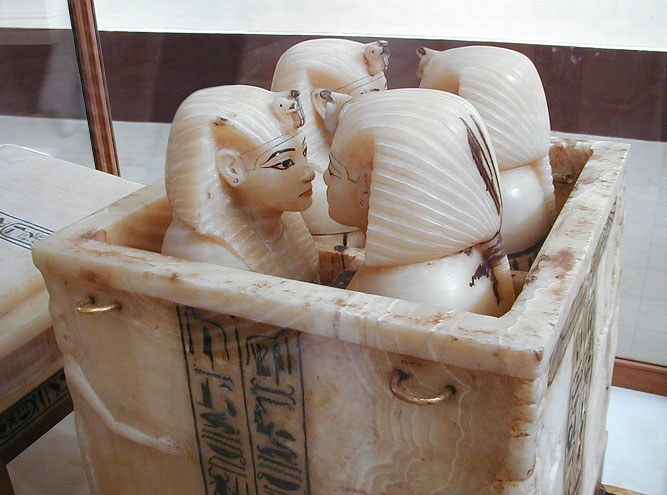|
Djehutynakht (10A)
Djehutynakht, tentatively identified with Djehutynakht IV or Djehutynakht V, was an ancient Egyptian "Overlord of the Hare nome" (the 15th nome of Upper Egypt) during the very end of the 11th Dynasty or the early 12th Dynasty (21st-20th century BCE). He is well known for his painted outer coffin (commonly called the “Bersha coffin”) now exhibited in the Museum of Fine Arts, Boston along with his other grave goods. Biography Once believed to have lived during the reign of pharaoh Senusret III of the 12th Dynasty, from the analysis of his furniture it has been deducted that he actually lived in an earlier period, although a degree of uncertainty still remains: it is very difficult to trace Djehutynakht's family and life events, and the only certain relationship is that with his wife, also named Djehutynakht. The name was very common in this period and six nomarchs bearing it are known, two of whom – the fourth and the fifth respectively – were married to a wife with the sam ... [...More Info...] [...Related Items...] OR: [Wikipedia] [Google] [Baidu] |
11th Dynasty
The Eleventh Dynasty of ancient Egypt (notated Dynasty XI; ) is a well-attested group of rulers. Its earlier members before Pharaoh Mentuhotep II are grouped with the four preceding dynasties to form the First Intermediate Period, whereas the later members are considered part of the Middle Kingdom. They all ruled from Thebes in Upper Egypt. Characteristics The relative chronology of the 11th Dynasty is well established by contemporary attestations and, except for count Intef and Mentuhotep IV, by the Turin canon.mirror Manetho's statement that the 11th Dynasty consisted of 16 kings, who reigned for 43 years is contradicted by contemporary inscriptions and the evidence of the Turin King List, whose combined testimony establishes that this kingdom consisted of seven kings who ruled for a total of 143 years. However, his testimony that this dynasty was based at Thebes is verified by the contemporary evidence. It was during this dynasty that all of ancient Egypt was united under ... [...More Info...] [...Related Items...] OR: [Wikipedia] [Google] [Baidu] |
George Andrew Reisner
George Andrew Reisner Jr. (November 5, 1867 – June 6, 1942) was an American archeologist of Ancient Egypt, Nubia and Palestine. Early life Reisner was born on November 5, 1867, in Indianapolis. His parents were George Andrew Reisner Sr. and Mary Elizabeth Mason. His father's parents were of German descent. Academic career Reisner began his studies at Harvard University in 1885. There he gained a B.A. degree in 1889, followed by a M.A. in 1891 and a Ph.D in Semitic Languages in 1893. With the support of his advisor, assyriologist David Gordon Lyon, he became a traveling fellow and started postdoctoral work in Berlin for three years. In Germany, Reisner studied hieroglyphics with Kurt Sethe and turned towards Egyptology as his main field. Reisner was elected to the American Academy of Arts and Sciences in 1914 and the American Philosophical Society in 1940. In 1889, Reisner was head football coach at Purdue University, coaching for one season and compiling a record of 2– ... [...More Info...] [...Related Items...] OR: [Wikipedia] [Google] [Baidu] |
21st-century BC Egyptian People
File:1st century collage.png, From top left, clockwise: Jesus is crucified by Roman authorities in Judaea (17th century painting). Four different men ( Galba, Otho, Vitellius, and Vespasian) claim the title of Emperor within the span of a year; The Great Fire of Rome (18th-century painting) sees the destruction of two-thirds of the city, precipitating the empire's first persecution against Christians, who are blamed for the disaster; The Roman Colosseum is built and holds its inaugural games; Roman forces besiege Jerusalem during the First Jewish–Roman War (19th-century painting); The Trưng sisters lead a rebellion against the Chinese Han dynasty (anachronistic depiction); Boudica, queen of the British Iceni leads a rebellion against Rome (19th-century statue); Knife-shaped coin of the Xin dynasty., 335px rect 30 30 737 1077 Crucifixion of Jesus rect 767 30 1815 1077 Year of the Four Emperors rect 1846 30 3223 1077 Great Fire of Rome rect 30 1108 1106 2155 Boudican ... [...More Info...] [...Related Items...] OR: [Wikipedia] [Google] [Baidu] |
Officials Of The Twelfth Dynasty Of Egypt
An official is someone who holds an office (function or Mandate (politics), mandate, regardless of whether it carries an actual Office, working space with it) in an organization or government and participates in the exercise of authority (either their own or that of their superior or employer, public or legally private). An elected official is a person who is an official by virtue of an election. Officials may also be appointed ''ex officio'' (by virtue of another office, often in a specified capacity, such as presiding, advisory, secretary). Some official positions may be Inheritance, inherited. A person who currently holds an office is referred to as an incumbent. Something "official" refers to something endowed with governmental or other authoritative recognition or mandate, as in official language, official gazette, or official scorer. Etymology The word ''official'' as a noun has been recorded since the Middle English period, first seen in 1314. It comes from the Old French ... [...More Info...] [...Related Items...] OR: [Wikipedia] [Google] [Baidu] |
Officials Of The Eleventh Dynasty Of Egypt
An official is someone who holds an office (function or mandate, regardless of whether it carries an actual working space with it) in an organization or government and participates in the exercise of authority (either their own or that of their superior or employer, public or legally private). An elected official is a person who is an official by virtue of an election. Officials may also be appointed ''ex officio'' (by virtue of another office, often in a specified capacity, such as presiding, advisory, secretary). Some official positions may be inherited. A person who currently holds an office is referred to as an incumbent. Something "official" refers to something endowed with governmental or other authoritative recognition or mandate, as in official language, official gazette, or official scorer. Etymology The word ''official'' as a noun has been recorded since the Middle English period, first seen in 1314. It comes from the Old French ' (12th century), from the Latin">-4; ... [...More Info...] [...Related Items...] OR: [Wikipedia] [Google] [Baidu] |
Nomarchs
A nomarch (, Great Chief) was a provincial governor in ancient Egypt; the country was divided into 42 provinces, called nomes (singular , plural ). A nomarch was the government official responsible for a nome. Etymology The term ''nome'' is derived from ''nomós'' "province, district". ''Nomarch'' is derived from ''nomárkhēs'': "province" + "ruler". Egyptian history The division of the Egyptian kingdom into nomes can be documented as far back as the reign of Djoser of the 3rd Dynasty in the early Old Kingdom, c. 2670 BCE, and potentially dates even further back to the Predynastic kingdoms of the Nile valley. The earliest topographical lists of the nomes of Upper and Lower Egypt date back to the reign of Nyuserre Ini, of the mid 5th Dynasty, from which time the nomarchs no longer lived at royal capital but stayed in their nomes. The power of the nomarchs grew with the reforms of Nyuserre's second successor, Djedkare Isesi, which effectively decentrali ... [...More Info...] [...Related Items...] OR: [Wikipedia] [Google] [Baidu] |
Siwa Oasis
The Siwa Oasis ( ) is an urban oasis in Egypt. It is situated between the Qattara Depression and the Great Sand Sea in the Western Desert (Egypt), Western Desert, east of the Egypt–Libya border and from the Egyptian capital city of Cairo. It is famed from its role in ancient Egypt as the home to an oracle of Amun, the ruins of which are a popular tourist attraction, giving it the ancient name Oasis of Amun-Ra, after the major Ancient Egyptian deities, Egyptian deity. Geography The oasis is in a deep Depression (geology), depression that reaches below sea level. To the west, the al Jaghbub Oasis rests in a similar depression and to the east, the large Qattara Depression is also below sea level. The depression is fertile due to both natural Artesian well, flowing artesian wells and irrigation. It is the site of about 200 natural springs. Siwa is directly adjacent to the Libyan Desert plateau. The geology is characterised by horizontal layers of porous limestones alternated wi ... [...More Info...] [...Related Items...] OR: [Wikipedia] [Google] [Baidu] |
Berbers
Berbers, or the Berber peoples, also known as Amazigh or Imazighen, are a diverse grouping of distinct ethnic groups indigenous to North Africa who predate the arrival of Arab migrations to the Maghreb, Arabs in the Maghreb. Their main connections are identified by their usage of Berber languages, most of them mutually unintelligible, which are part of the Afroasiatic languages, Afroasiatic language family. They are indigenous peoples, indigenous to the Maghreb region of North Africa, where they live in scattered communities across parts of Morocco, Algeria, Libya, and to a lesser extent Tunisia, Mauritania, northern Mali and northern Niger. Smaller Berber communities are also found in Burkina Faso and Egypt's Siwa Oasis. Descended from Stone Age tribes of North Africa, accounts of the Imazighen were first mentioned in Egyptian hieroglyphs, Ancient Egyptian writings. From about 2000 BC, Berber languages spread westward from the Nile, Nile Valley across the northern Sahara int ... [...More Info...] [...Related Items...] OR: [Wikipedia] [Google] [Baidu] |
Boston
Boston is the capital and most populous city in the Commonwealth (U.S. state), Commonwealth of Massachusetts in the United States. The city serves as the cultural and Financial centre, financial center of New England, a region of the Northeastern United States. It has an area of and a population of 675,647 as of the 2020 United States census, 2020 census, making it the third-largest city in the Northeastern United States after New York City and Philadelphia. The larger Greater Boston metropolitan statistical area has a population of 4.9 million as of 2023, making it the largest metropolitan area in New England and the Metropolitan statistical area, eleventh-largest in the United States. Boston was founded on Shawmut Peninsula in 1630 by English Puritans, Puritan settlers, who named the city after the market town of Boston, Lincolnshire in England. During the American Revolution and American Revolutionary War, Revolutionary War, Boston was home to several seminal events, incl ... [...More Info...] [...Related Items...] OR: [Wikipedia] [Google] [Baidu] |
Middle Kingdom Of Egypt
The Middle Kingdom of Egypt (also known as The Period of Reunification) is the period in the history of ancient Egypt following a period of political division known as the First Intermediate Period of Egypt, First Intermediate Period. The Middle Kingdom lasted from approximately 2040 to 1782 BC, stretching from the reunification of Egypt under the reign of Mentuhotep II in the Eleventh Dynasty of Egypt, Eleventh Dynasty to the end of the Twelfth Dynasty of Egypt, Twelfth Dynasty. The kings of the Eleventh Dynasty ruled from Thebes, Egypt, Thebes and the kings of the Twelfth Dynasty ruled from Lisht, el-Lisht. The Periodization of ancient Egypt, concept of the Middle Kingdom as one of three golden ages was coined in 1845 by German Egyptologist Christian Charles Josias von Bunsen, Baron von Bunsen, and its definition evolved significantly throughout the 19th and 20th centuries. Some scholars also include the Thirteenth Dynasty of Egypt wholly into this period, in which case the Mi ... [...More Info...] [...Related Items...] OR: [Wikipedia] [Google] [Baidu] |
Canopic Jar
Canopic jars are funerary vessels that were used by the Ancient Egypt, ancient Egyptians to house embalmed organs that were removed during the mummification process. They also served to store and preserve the viscera of their soul for the afterlife. Use of the jars dates back to the Old Kingdom of Egypt, Old Kingdom and continued until the Late Period of ancient Egypt, Late Period and the Ptolemaic Kingdom, Ptolemaic Period, after which time the viscera were simply wrapped and placed with the body. Over the course of ancient Egyptian history, various changes were made to the design and style of canopic jars. Contemporaneously, canopic jars are of interest for scientific and medical research. Cinerary urns – for holding the ashes of cremated persons – with a head-shaped lid, also sometimes called "canopic", were used by the Etruscan civilization. Though these vessels are sometimes referred to as "canopic urns" or "canopic jars", their purpose and use is not related to th ... [...More Info...] [...Related Items...] OR: [Wikipedia] [Google] [Baidu] |
Canopic Chest
Canopic chests are cases used by ancient Egyptians to contain the internal organs removed during the process of mummification. Once canopic jars began to be used in the late Fourth Dynasty, the jars were placed within canopic chests. Although the first proven canopic burials date from the Fourth Dynasty reign of Sneferu, there is evidence to suggest that there were canopic installations at Saqqara dating from the Second Dynasty.Dodson, Aidan, "Canopic Jars and Chests", in Redford, Donald B. (ed) (2001). ''The Oxford Encyclopedia of Ancient Egypt'', vol. II, Oxford University Press. pp. 231–235 Connections to Ancient Egyptian culture Canopic chests had an important place in Egyptian culture. Canopic chests contained the internal organs (viscera) of mummies, so they relate to the Egyptian belief that the afterlife is just as important as life on earth. Egyptians believed that everything had to be perfectly preserved to journey into the land after life and as part of the mum ... [...More Info...] [...Related Items...] OR: [Wikipedia] [Google] [Baidu] |





